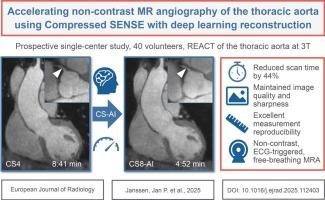Accelerating non-contrast MR angiography of the thoracic aorta using compressed SENSE with deep learning reconstruction
IF 3.3
3区 医学
Q1 RADIOLOGY, NUCLEAR MEDICINE & MEDICAL IMAGING
引用次数: 0
Abstract
Purpose
REACT (Relaxation-Enhanced Angiography without ContrasT) is a reliable non-contrast magnetic resonance angiography for imaging of the thoracic aorta but remains time-consuming. This study evaluates acceleration of image acquisition using compressed sensing and parallel imaging (Compressed SENSE, CS) combined with deep learning-based image reconstruction (CS-AI).
Methods
In this prospective single-center study, 40 volunteers underwent ECG- and navigator-triggered 3D REACT at 3 T using CS acceleration factor 4 (CS4; reference standard) and 8 (CS8). CS8 data were reconstructed with standard and CS-AI methods (CS8-AI). Two radiologists measured aortic diameters, rated subjective image quality and performed pairwise comparisons. Additionally, objective image quality metrics were calculated.
Results
Median scan time was reduced by 44 % (CS4: 8:41 min; CS8/CS8-AI: 4:52 min). All techniques showed excellent agreement in aortic diameter measurements (mean differences < 0.2 mm; P > 0.999). CS8-AI demonstrated reduced mean absolute deviation from CS4 compared to CS8 (0.67 vs. 0.77 mm; P = 0.003), and measurement variance was 40–50 % lower with CS8-AI than with CS8 (inter-/intrarater: P < 0.001), and comparable to CS4. CS8 showed significantly lower subjective image quality scores than CS4 (3.70[3.33–4.00] vs. 4.25[3.90–4.50]; P < 0.001), while CS8-AI showed comparable or higher scores (4.40[4.00–4.70]; P = 0.076). Forced-choice comparisons favored CS4 over CS8 (90 % vs. 2.5 %; P < 0.001), but no preference was observed between CS4 and CS8-AI (42.5 % vs. 37.5 %; P > 0.999). Objective metrics predominantly confirmed the subjective results.
Conclusion
Deep learning-based reconstruction enables the acquisition of REACT of the thoracic aorta in less than five minutes while preserving high image quality and maintaining excellent measurement reproducibility.

基于深度学习重建的压缩SENSE加速非对比MR血管造影。
目的:REACT(无对比松弛增强血管造影)是一种可靠的无对比磁共振血管造影,但仍然耗时。本研究评估了使用压缩感知和并行成像(compressed SENSE, CS)结合基于深度学习的图像重建(CS- ai)的图像采集加速。方法:在这项前瞻性单中心研究中,40名志愿者在3t时使用CS加速因子4 (CS4;参考标准)和8 (CS8)接受ECG和导航仪触发的3D REACT。采用标准和CS-AI方法重建CS8数据(CS8- ai)。两名放射科医生测量了主动脉直径,评定了主观图像质量,并进行了两两比较。此外,还计算了客观图像质量指标。结果:中位扫描时间缩短44% (CS4: 8:41 min; CS8/CS8- ai: 4:52 min)。所有技术在主动脉直径测量上均表现出良好的一致性(平均差值0.999)。与CS8相比,CS8- ai与CS4的平均绝对偏差减小(0.67 vs. 0.77 mm; P = 0.003), CS8- ai的测量方差比CS8低40- 50%(内部/内部:P 0.999)。客观指标主要证实了主观结果。结论:基于深度学习的重建可以在不到5分钟的时间内获得胸主动脉的反应,同时保持高图像质量和良好的测量再现性。
本文章由计算机程序翻译,如有差异,请以英文原文为准。
求助全文
约1分钟内获得全文
求助全文
来源期刊
CiteScore
6.70
自引率
3.00%
发文量
398
审稿时长
42 days
期刊介绍:
European Journal of Radiology is an international journal which aims to communicate to its readers, state-of-the-art information on imaging developments in the form of high quality original research articles and timely reviews on current developments in the field.
Its audience includes clinicians at all levels of training including radiology trainees, newly qualified imaging specialists and the experienced radiologist. Its aim is to inform efficient, appropriate and evidence-based imaging practice to the benefit of patients worldwide.

 求助内容:
求助内容: 应助结果提醒方式:
应助结果提醒方式:


